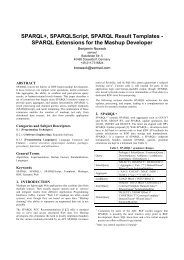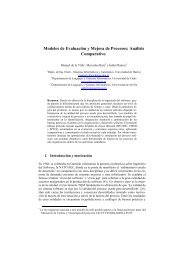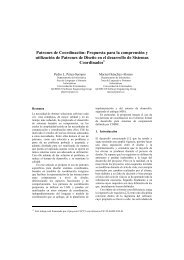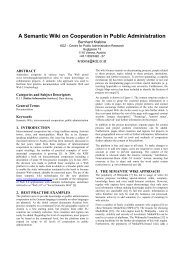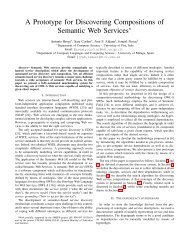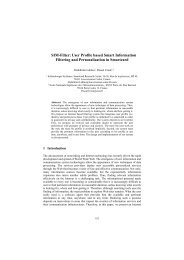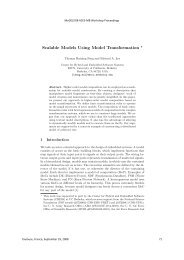ontology-based information extraction systems (obies 2008)
ontology-based information extraction systems (obies 2008)
ontology-based information extraction systems (obies 2008)
You also want an ePaper? Increase the reach of your titles
YUMPU automatically turns print PDFs into web optimized ePapers that Google loves.
The agents are Java classes that extend the jade.core.Agent 1 . They run in a JADE<br />
container and use standard ACL (Agent Communication Language) 2 means of<br />
interaction. All agents share a set of simple calls. Most calls consist of the name of the<br />
addressed agent and a simple German codeword: los (go), mehr (more), fertig (done).<br />
Only the tidy-up agent Paula is also assigned a more sophisticated command when<br />
she has to reorganize results for presentation: sumup (sum up). When broadcasting the<br />
close-down message to all agents, Kurt says schluss (finish) to make the agents delete.<br />
The system blackboards serve data communication. The ScenarioBoard stores<br />
the query specification and the findings of the agents. While they interpret a sentence,<br />
the agents exchange data via the TextBlackBoard. External input comes from the text<br />
passage retrieval result. At the end of a session, the retrieval result (organized in<br />
documents, paragraphs and sentences) is augmented with the agents’ relevance<br />
judgements. They mark the relevant text clips, which are presented to the user.<br />
Fig. 2. The agents and their communication network. Dotted arcs represent data input/output<br />
2. The Ontology<br />
The agents and the system users share an <strong>ontology</strong> of the application domain Bone<br />
Marrow Transplantation (BMT). The <strong>ontology</strong> was developed by human experts from<br />
a corpus of US BMT papers and user queries of physicians at Hanover Medical<br />
School. It is stored in a MySQL 3 database. In the <strong>ontology</strong> the agents find the types of<br />
knowledge they need for IE (see Table 1): concepts, propositions, proposition syntax<br />
records, unifiers, paraphrases, scenarios, and some technical help tables.<br />
We use a Prolog style first order predicate logic representation. Inside the<br />
MySQL database, all knowledge items are split into separate tables. Propositions<br />
1 See JADE at http://jade.tilab.com/<br />
2 http://www.fipa.org/repository/aclspecs.html<br />
3 http://www.mysql.de/



